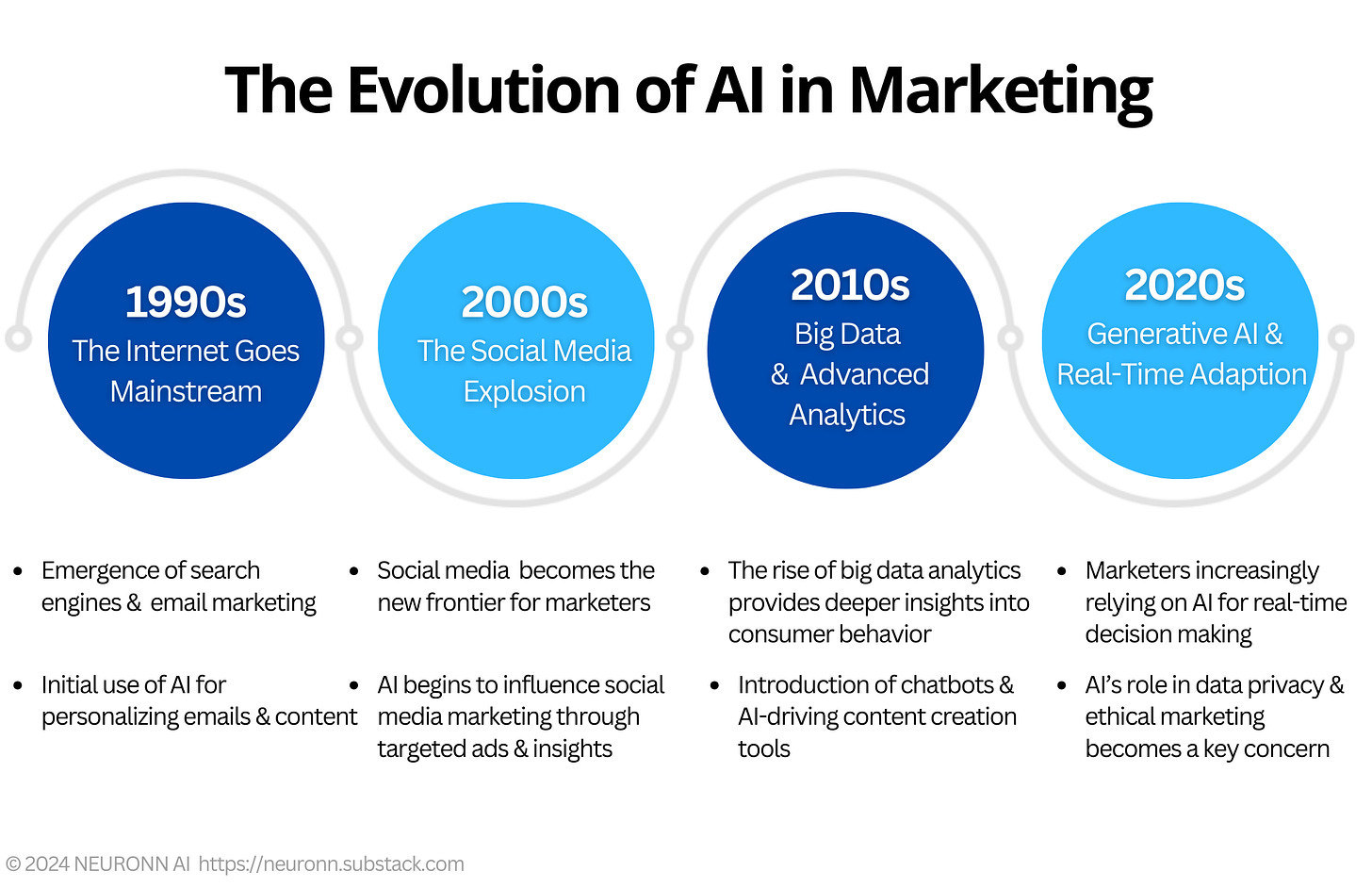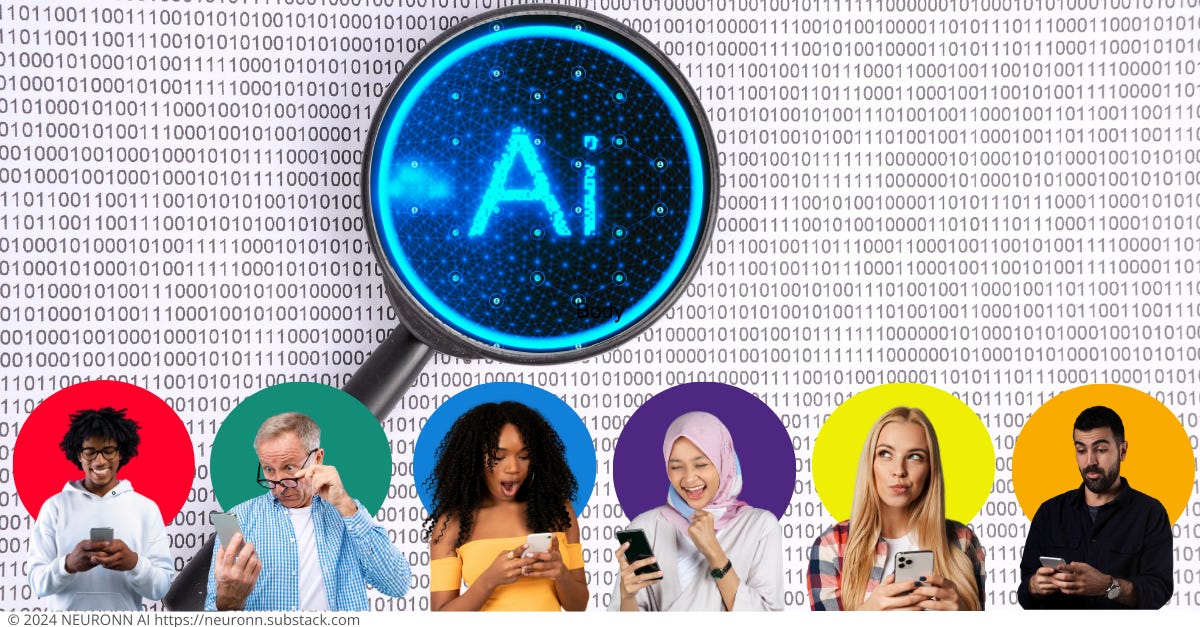Imagine a bustling marketplace where chaos once reigned, and vendors shouted to attract attention. Today, precision rules this marketplace with artificial intelligence (AI) whispering tailored messages to each customer, knowing each individual’s preferences, past purchases, and even unarticulated needs.
This shift from broad strokes to precision engagement exemplifies the power of AI in marketing.
AI is transforming business and personal life at an incredible pace, with marketing being no exception. From predicting consumer behavior to crafting personalized messages and experiences, AI enhances how businesses engage with their audiences. Enter Generative AI (GenAI), which promises even greater transformative changes.
This article explores how AI and GenAI are transforming marketing, focusing on insights, providing businesses with a competitive edge through enhanced marketing research and real-time adaptability. In our next article, we will dive deeper on practical applications of AI and Gen AI in strategic marketing.
The Evolution of Marketing
Marketing’s core goal has always been to understand and satisfy customer needs. Back in the 1990s, this meant relying on broad demographic data, coupled with some advanced analytics and a lot of intuition. By 2024, AI brought data-driven precision, enabling real-time customer segmentation, sentiment analysis, and predictive analytics. These tools allowed highly personalized and effective marketing strategies.
GenAI took this further by adapting and creating in real-time, enabling instant adjustments and a more engaging customer experience. While traditional AI focuses more on data analysis and optimization, GenAI excels in transforming the creative aspects of research and marketing.

Traditionally, launching a new product, crafting an ad campaign, and developing a go-to-market (GTM) plan could take weeks or months. AI and GenAI revolutionize this process by instantly analyzing vast amounts of data to predict market trends and customer needs, refining products, and fine-tuning messaging strategies. They dynamically adjust campaigns in real-time to maximize engagement and ROI, making the entire process more efficient and responsive, greatly enhancing the effectiveness of marketing campaigns.
Bringing us to the present, let’s explore the insights and analytics journey in more detail for marketers leveraging AI and GenAI.
How AI and GenAI Enhance Real-Time Understanding and Learning
Practical Applications in Marketing Research
Meet Ava, a dedicated Marketing Manager at a domestic travel app company. Despite the industry’s continuous growth, Ava’s app faced stagnant new customer acquisition. Seeking fresh perspectives, Ava turned to AI and GenAI for rapid, deep insights on market trends, customer needs and behavior for product refinement and enhanced ad campaigns.
Understanding the Market and Trends
Ava began by exploring the domestic travel app landscape, partnering with companies that utilize AI to analyze market trends, category sentiment, competitor product launches, pricing strategies, brand perceptions, and customer feedback. These tools analyzed publicly available web-based sources, monitored competitor websites, identified brand assets in images and performed visual analytics, conducted topic and sentiment analysis using natural language processing (NLP).
Using GenAI, Ava synthesized diverse data sources, including text, images, and social media, to generate context-rich analyses and uncover deeper insights. Her reports automatically adapted to new data inputs in real-time, dynamically adjusting analyses and predictions. This capability provided Ava with immediate strategic recommendations and content adjustments, ensuring she could promptly respond to market changes.
AI tools surpass traditional tracking methods by efficiently identifying market gaps and highlighting underserved segments. This fast and comprehensive market analysis enabled Ava to uncover new opportunities for product refinement and growth effectively.
Example tools: Brandwatch, Crayon, Sprinklr and Talkwalker
Prioritizing Addressable Target by Segmentation, Personas, and Customer Journeys
To target more effectively, Ava used AI to create detailed customer personas. She integrated data from surveys, social media, and other sources to uncover patterns and trends, segmenting customers based on demographics, psychographics, motivations, attitudes, preferences, and behaviors. The analysis and segmentation identified high-value customer segments to effectively address the stagnation.
She then leveraged GenAI, integrating structured data such as demographics, browsing habits, and purchase history with unstructured data from social media posts and customer feedback. This enabled her to generate personalization at scale through detailed customer journeys and personas. These insights helped her identify and optimize key touchpoints for prioritized customer segments, enhancing overall customer engagement.
Example tools: Acxiom, Resonate, Salesforce’s Einstein, and Segment
Exploring Unique Customer Needs, Motivators, Barriers
For the prioritized, high-value customer segments, Ava conducted mobile ethnography studies to gain richer insights into human behavior and cultural contexts, as well as qualitative research, virtual focus groups, to identify specific needs, motivators, and barriers to engaging with their travel app. These tools utilize NLP and machine learning (ML) to effortlessly analyze data, revealing key themes and sentiments. Leveraging AI-driven qualitative research tools, Ava efficiently gained deeper insights into customer needs, motivators, and pain points, saving time and effort.
The technology built around new GenAI capabilities in large language models (LLMs) enhanced the effectiveness and depth of Ava’s qualitative research by enabling real-time analysis and dynamic question adaptation, providing deeper insights during qualitative sessions. She then utilized these tools to produce reasonably accurate transcriptions, concise summaries, and detailed reports featuring themes, sentiments, and visuals such as word clouds, sentiment graphs, and thematic maps. AI and GenAI allowed Ava to spend less time on basic research processes and focus more on interpretation and strategy.
Example tools: Atlas.ti, Dovetail, Fjord, Lucidchart, NVivo, Otter.ai, Remesh, and Scribie
Evaluating Brand Strengths and Weaknesses
Meanwhile, through custom quantitative research, she identified the brand strengths and areas for improvement by focusing on unmet customer needs. AI technologies optimized survey design and data collection, and ensured higher response rates and relevant data by targeting the right respondents.
Utilizing NLP, GenAI analyzed open-ended survey responses, facilitated adaptive questioning, and extracted themes, sentiments, and key insights, delivering prompt, actionable findings.
GenAI also conducted predictive analytics using first-party and survey data to anticipate future customer needs and preferences. These tools use AI-based predictive models to simulate the responses that ‘real’ humans would give to certain inputs or stimuli. By integrating these AI and GenAI capabilities with traditional research, Ava could more effectively and swiftly pinpoint areas for refining the product and brand, guiding proactive strategies.
Example tools: BigQuery, Einstein, QuestionPro, RapidMiner, SAS, Typeform, Verint, Voxco, and Zoho Survey
Understanding Product Experience and Rapid Prototyping
Ava also conducted UX and CX research to gain detailed insights into user experience and satisfaction with their app. AI-driven behavior analysis tools enabled Ava to track and understand customer interactions on the travel app, websites, and social media in real-time. AI-powered chatbots gathered valuable data while providing real-time customer support. These tools offered integrations with a wide array of unstructured feedback sources, such as reviews data, complaints, support tickets, feature requests, bug notes, and NPS verbatims.
Leveraging AI tools for UX research, Ava analyzed user interactions to identify areas for improvement. These insights facilitated rapid prototyping and iterative design enhancements, refining product features and customer service approaches.
Example tools: HubSpot, Intercom, Lookback, Maze, Medallia, Userzoom, and Zendesk
Campaign Tracking and Optimization
Finally, Ava evaluated the effectiveness and impact of both online and offline campaigns by integrating AI approaches. This allowed her to go beyond basic metrics like awareness, stated engagement, purchase intent, reach, impressions, and click-through rates (CTR).
AI tools provided deeper insights, including customer lifetime value (CLV), engagement scores, sentiment analysis, multi-touch attribution, and ROI. By automatically collecting and integrating data from cross-channel sources—such as the app, social media, websites, CRM systems, offline sources via QR/promo codes, sales data, and third-party platforms—Ava received a more comprehensive view of campaign performance.
GenAI enabled advanced personalization by analyzing user behaviors, preferences, and interactions, delivering tailored content and ads to specific audience segments while dynamically adjusting ad placement, content, and targeting to enhance campaign performance. This also allowed Ava’s team to make real-time adjustments, optimizing campaign elements on the fly.
Example tools: Adobe Analytics, Conviva, Google Analytics, Hootsuite, and Quancast
An Evolving Landscape
The AI research methods and tools discussed in this article serve as examples. The field of marketing research is evolving quickly, as evidenced by the detailed list provided below. It’s crucial to carefully evaluate the capabilities of these tools and choose those that meet your research objectives, complement or replace conventional methods, and fit your budget and timeline.
Neuronn AI is not affiliated with the companies mentioned in this article.

Key Considerations When Harnessing AI and GenAI in Marketing Research
Leveraging AI and GenAI for marketing research, insights, and analytics can transform how businesses understand and engage with their customers. These emerging technologies provide real-time, multi-channel data integration, deeper analysis, and rapid response capabilities.
However, businesses must be aware of potential pitfalls such as over-reliance on AI and implementation challenges. It’s crucial to prioritize actionable insights and scalability to truly harness AI’s power. Solely depending on AI without human oversight and interpretation can lead to misinformed decisions. Combining AI-driven insights with human expertise prevents data hallucinations, ensures accurate interpretation, and validates findings within the proper context.
Additionally, upholding ethical standards and transparency in handling customer data is essential, ensuring compliance with data privacy regulations such as GDPR, CCPA, and the EU AI Act. Companies must strive for data quality and mitigate bias since AI models typically require large and diverse datasets to yield meaningful, unbiased results.
Lastly, companies should consider the costs and effort associated with implementing AI solutions, including software, hardware, and talent to ensure they have the necessary resources and expertise to select, manage, and maintain proper tools effectively. Prioritizing the right tools, seamlessly integrating AI with existing systems, maintaining data privacy compliance, and combining AI insights with human expertise are vital for achieving optimal outcomes.
About Neuronn AI
Neuronn AI is a professional advisory group rooted in prominent Artificial Intelligence companies such as Meta. Leveraging extensive expertise in Data Science & Data Engineering, AI Product Management, Marketing Research, and Strategic and Brand Marketing, we offer fractional assistance to startups looking to launch AI-driven product ideas and provide consulting services to enterprises seeking to implement AI to accelerate their outcomes.

Leave a Reply